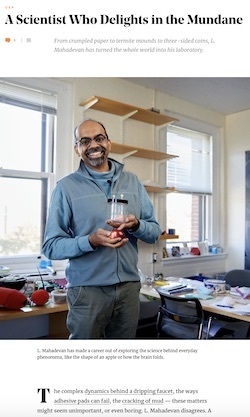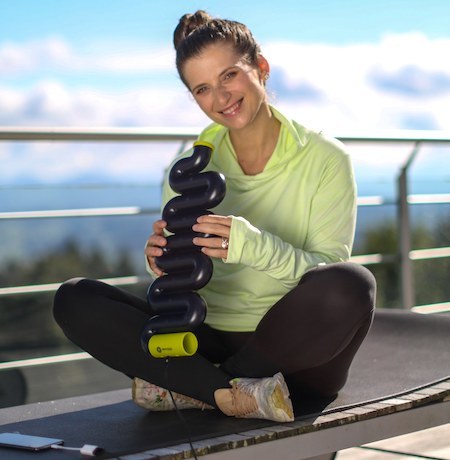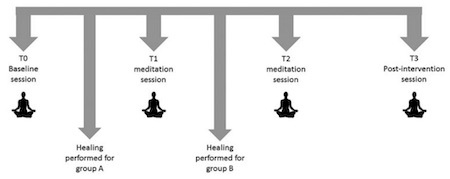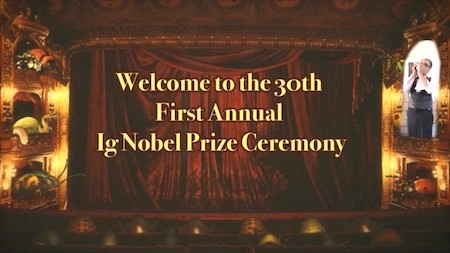Marc Abrahams's Blog, page 97
November 1, 2020
Pocket-Sized #1040: “Automatically Recognize Boredom”
In this Pocket-Sized episode #1040, Marc Abrahams shows some unfamiliar research studies to Nicole Sharp. Dramatic readings and reactions ensue.
The research mentioned in this episode is featured in the special Time & Boredom issue (Vol. 22, #3) of the Annals of Improbable Research Magazine.

Remember, our Patreon donors, on most levels, get access to each podcast episode before it is made public.
Nicole Sharp encounters:
“A Preliminary System for Recognizing Boredom,” Allison M. Jacobs, Benjamin Fransen, J. Malcolm McCurry, Frederick WP Heckel, Alan R. Wagner, and J. Gregory Trafton, Proceedings of the 4th ACM/IEEE International Conference on Human Robot Interaction, 2009, pp. 299-300.
Seth Gliksman, Production Assistant
Available on Spotify, Apple Podcasts, Overcast, Google Podcasts, AntennaPod, BeyondPod and elsewhere!

October 30, 2020
Silent Sleep Training Medical Didgeridoo
It has been announced: “The Silent Sleep Training Medical Didgeridoo has been proven in two medical studies at the University Hospital of Zurich, Switzerland. The results of the first study were published in the renowned British Medical Journal and in 2017 the research team was awarded the Ig Nobel Prize.”
Further info is available on the inventors’ web site, which includes this video:

October 29, 2020
Spell-Checking: Randomized Controlled Trial of Pagan Spells
Randomized controlled trials of pagan spells are rarely reported in the medical literature. Here is a new addition to the world’s collection:
“Testing the Pagan Prescription: Using a Randomized Controlled Trial to Investigate Pagan Spell-Casting as a Form of Noncontact Healing,” Charmaine Sonnex, Chris A. Roe, and Elizabeth C. Roxburgh, The Journal of Alternative and Complementary Medicine, vol. 26, no. 3, 2020, pp. 219-225. (Thanks to Kristine Danowski for bringing this to our attention.) The authors, at the University of Buckingham, the University of Northampton, and Nottingham Trent University, explain:
Pagan spell-casting practices have received little attention from distance healing researchers. This study aims to address this gap in the literature.
Design: This study utilized a randomized, double-blind, delayed intervention design.
Subjects: Forty-four participants (30 females, 14 males) were recruited using snowball sampling (mean age=24.30; range=18–55).
Procedure: Participants were randomly allocated to either Group A or B. Participants made written requests to the practitioner about changes they would like to see in their lives and provided a photograph and personal item to be used during the intervention. Participants attended meetings once a week during which they would take part in a guided body scan meditation before completing a quality-of-life measure. Healing practices were conducted for Group A between weeks 1 and 2 and for Group B between weeks 2 and 3.
Outcome Measure: Well-being was measured using the 26-item WHOQOL-BREF.
Results: Multivariate analysis of variance (MANOVA) showed a significant, positive change in general health from weeks 1 to 4 (F=4.02, p=0.025, η2=0.149). Separate analysis of variances of the four WHOQOL domains showed significant improvements across the study in the physical and psychologic domains only; there was no significant group difference on any of the outcomes….
Conclusions: The aims of this study were to show how recommendations made by Roe et al. might be implemented in subsequent RCT designs that test claims for noncontact healing, and to explore whether claims for the efficacy of Pagan healing practices could be tested within an RCT paradigm. The study described here was successful insofar as it was able to demonstrate that an im- provement in well-being can beproduced within an RCT test of Pagan spell-casting. The fact that these improvements could not be attributed to the healing interventionper se, despite the domains of improvement reflecting participant requests, highlights areas for improvement in future research with Pagan healers.

October 28, 2020
An Extraordinary Scientist Who Delights in the Mundane
Ig Nobel Prize winner L. Mahadevan is profiled, by Steve Nadis, in Quanta magazine:

A Scientist Who Delights in the Mundane
Mahadevan uses mathematics and physics to explore commonplace phenomena, showing that many of the objects and behaviors we take for granted, and consequently give little thought to, are quite extraordinary upon closer examination… He even took on a process often dismissed as the dullest thing imaginable in his essay “Watching Paint Dry,” …
I’m not the kind of person who thinks some problems are bigger than others. In my mind, there is no hierarchy. What is frivolous and what is important seems like an irrelevant question. After all, nature does not care! …
I work on things that everyone can see and experience, but few care to think about deeply. As for the second question, does an artist, musician or writer think about applications? Why does science have to do so? It is human to be curious. That is enough, isn’t it?
But I should add that I’m not at all snooty about working on useful or practical things. I have patents on a few devices and algorithms, and just this year we developed potential protocols for mitigating the extreme costs of pandemics.
On the other hand, I also like doing things for the sheer fun of it, like, for instance, designing a fair three-sided coin in order to decide a three-way bet….
The 2007 Ig Nobel Prize for physics was awarded to L. Mahadevan of Harvard University, USA, and Enrique Cerda Villablanca of Universidad de Santiago de Chile, for studying how sheets become wrinkled.
That research is documented in these studies:
“Wrinkling of an Elastic Sheet Under Tension,” E. Cerda, K. Ravi-Chandar, L. Mahadevan, Nature, vol. 419, October 10, 2002, pp. 579-80.
“Geometry and Physics of Wrinkling,” E. Cerda and L. Mahadevan, Physical Review Letters, fol. 90, no. 7, February 21, 2003, pp. 074302/1-4.
“Elements of Draping,” E. Cerda, L. Mahadevan and J. Passini, Proceedings of the National Academy of Sciences, vol. 101, no. 7, 2004, pp. 1806-10.

October 27, 2020
Health announcements in the year 2020
People are trying new ways to try to educate the public, in the vexed year 2020, about health care and safety. This video is, perhaps, a bold experiment:
(Thanks to @Beccanalia for bringing this to our attention.)

October 26, 2020
Patent simplicity : ‘Beach Blanket’ [patent]
When it comes to simple, yet patentable ideas, it’s not easy to find a better example than US Patent 7096526B1 granted in 2006 to inventor Laura E Ogan – entitled ‘Beach Blanket’.
“People go to the beach for relaxation. One of the usual objects that is brought to the beach for comfort is a towel. It can be a big towel that is spread on the sand and where people sit or lie on. The ordinary towel comes in many sizes and shapes. It is square, rectangular or round. The beach umbrella is almost always round. When the heat becomes uncomfortable, a beach umbrella is brought out to provide shade.
Ordinarily, comfort given by the towel and the umbrella is limited to one side and is not maximized. With a round, rectangular or square towel that has one hole in the middle and one hole in any of the edges or perimeter where the handle of the umbrella is planted in any of the two holes, shade is maximized and comfort enjoyed by whoever is seated, lying down or standing on the towel.
This kind of beach towel may be used not only in beaches but also in front and back yards, parks, playgrounds, camps, picnic areas or any place where relaxation and comfort benefit users who prefer lying down or sitting on towels rather than sitting on chairs.”
See US Patent 7096526B1, Beach Blanket
Note that, as the patent document points out :
● The hole does not have to be in the centre
● There can be more than one hole
● The blanket does not have to be rectangular
Research research by Martin Gardiner

October 25, 2020
Pocket-Sized #1039: “The A-through-L of Social Dilemmas”
In this Pocket-Sized episode #1039, Marc Abrahams shows an unfamiliar research study to Robin Abrahams. Dramatic readings and reactions ensue.
Remember, our Patreon donors, on most levels, get access to each podcast episode before it is made public.
1. Robin Abrahams encounters:
Etiquette, by Emily Post, 1942.
Seth Gliksman, Production Assistant
Available on Spotify, Apple Podcasts, Overcast, Google Podcasts, AntennaPod, BeyondPod and elsewhere!

Jost Migenda joins the Luxuriant Flowing Hair Club for Scientists (LFHCfS)
Jost Migenda has joined the Luxuriant Flowing Hair Club for Scientists (LFHCfS). They say:
While black holes are widely suspected to have no hair[*], many astrophysicists do. During my research on the explosion mechanism of supernovae (magnificent astrophysical events that produce black holes or neutron stars), I have made an even more exciting discovery: Untangling the mysteries of the universe is twice as fun if you can untangle your hair at the same time!
Jost Migenda, Ph.D., MInstP, LFHCfS
Postdoctoral Research Associate
King’s College London
London, United Kingdom


A Hypercubic Appraisal of This Year’s Ig Nobel Prizes
The Hypercubic blog has a thoughtful essay about this year’s Ig Nobel Prizes and ceremony. (The essay is in Portuguese—if you don’t read the language easily, you might enjoy reading it via a machine translation program). It begins [here in translation]:
IgNobel 2020: the most unlikely polls of the year
TRADITION IS A KNIFE OF TWO VEGETABLES : on the one hand, it is legal to carry on the habits and customs of previous generations; on the other hand, a tradition can easily become a bond, a paralyzing force, ready to trap us in a past that no longer exists or has never existed. Creative people, like scientists and artists, tend to have little reverence for established traditions. This does not mean that there are no traditions in these areas.
An irreverent tradition of the scientific community, for example, is the IgNobel Award. Dedicated to disseminating research that first makes you laugh, then think, IgNobel has traditionally been held in mid-September since 1990. The 30th . The first edition, therefore, would be a good reason to fill the stage, the auditorium and the galleries of the Sanders Theater, in Harvard, last Thursday (17/09). However, for the first time, this traditional location could not be the setting for the most unceremonious ceremony in the scientific community.
The IgNobel committee may be cute, but it is not stupid. Given the extraordinary conditions of a year as buggy as 2020, it would be impossible to bring together about a thousand fans and scientists in a closed environment and without social distance like a theater. Thus, IgNobel left behind one tradition and resorted to another…

October 23, 2020
Why did we vibrate earthworms?
The winners of the 2020 Ig Nobel Prize for physics wrote about their work, in The Conversation: “We vibrated earthworms to learn about safely connecting human brains to computers”

Marc Abrahams's Blog
- Marc Abrahams's profile
- 14 followers








